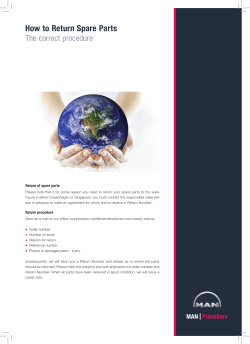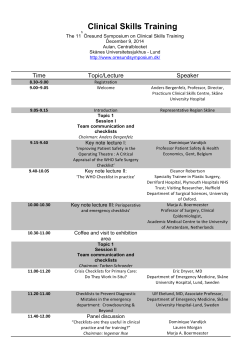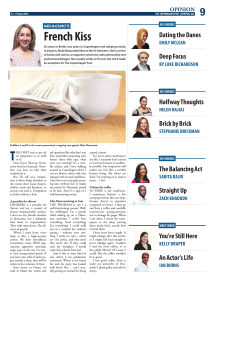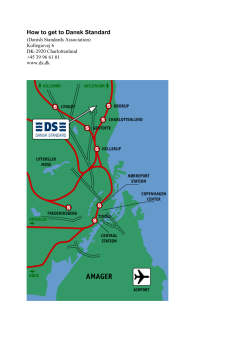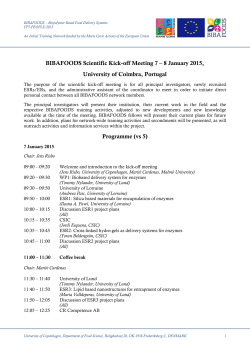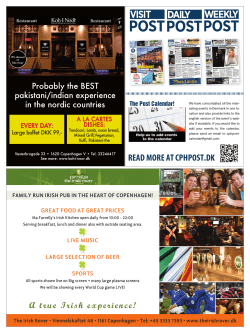
Regulatory capacity building and NDRA approvals of prequalified
Regulatory capacity building and NDRA approvals of prequalified products Milan Smid Prequalification team Principal objective of PQP capacity building: To facilitate availability of quality priority medicines • Good quality submissions and compliance with "good practices" • Strengthening of regulatory functions and fast approvals of PQd medicines • Reliable quality monitoring PQP builds capacity in general: – – PQP technical expertise is used in support of capacity building of regulators, quality control laboratories and manufacturers WHO/PQP standards and PQP example support strengthening of regulatory systems and manufacturing capacity Focus on regulators in: – – – Countries recipient PQ medicines Major producing countries without stringent regulation Other countries of specific need Copenhagen, May 2014 2 Capacity building resources • All PQ team is involved • Close co-operation with WHO colleagues, many collaborating organizations, pool of external experts • Funding coming from several donors, especially UNITAID, BMGF, GFATM, UNCoLSP, USFDA … Copenhagen, May 2014 3 Frequent partners in capacity building • • • • • • • • • • • • • • European Directorate for the Quality of Medicines & Healthcare (EDQM) International Pharmaceutical Federation (FIP) United Nations Population Fund (UNFPA) National Regulatory Authorities in UK, Canada, South Africa, Tanzania, Estonia, Ethiopia, Ukraine, Morocco, Brazil, Jordan, Ghana, Egypt, Indonesia, Kenya, Uganda, China National Quality Control Laboratories in Morocco and Tanzania East Africa Community (EAC) Association of Southeast Asian Nations (ASEAN) Ministry of Health China, Pakistan, Morocco Program for Appropriate Technology in Health (PATH) European Medicines Agency (EMEA) Drug Information Association (DIA) Therapeutic Goods Agency Australia (TGA) Roche Pharmaceuticals …………….. Copenhagen, May 2014 4 Key capacity building approaches 1) Training activities of different set-up 2) Technical assistance & 3) Provision of information, consultancy standards and regulatory expertise Copenhagen, May 2014 5 Trainings: individualized and collective (seminars and workshops) • Training of regulators integrated into core PQP activities – – – – – – – – NMRA assessors in PQ assessment NMRA inspectors in PQ inspections NMRAs professionals in quality monitoring of medicines Rotations of assessors and inspectors from NMRAs Joint problem solving Joint assessments Collaborative registrations Informal audits of manufacturers, QCLs and CROs with training effect Copenhagen, May 2014 6 Seminars and workshops • Frequent collaboration with third parties Copenhagen, May 2014 7 Seminars and workshops • Trainings of NRA staff and manufacturers frequently combined Copenhagen, May 2014 8 Why trainings with combined audience of regulatory and regulated professionals? • Need to combine objectives due to agreements with donors • PQ of prioritized medicines is key PQT deliverable • Common technical understanding needed by manufacturers and regulators • Facilitation of communication • On site problem solution • Less expensive • Easier to measure the outcome Copenhagen, May 2014 9 Seminars and workshops • General: PQ procedures and WHO requirements • Technical, to reflect identified needs, e.g.: − − − − − − Product specific: HIV/AIDS, TB, antimalarial or RH products Pharmaceutical development/paediatric dosage forms Quality of APIs, Stability testing Manufacture of sterile medicines Bioequivalence testing and GCP Dissolution and water determination, microbiological testing, HPLC analyses, quality management system Copenhagen, May 2014 10 Copenhagen, May 2014 11 Copenhagen, May 2014 12 Provision of information and regulatory expertise • Information related to individual PQ products or manufacturers /CROs http://www.who.int/prequal – – – – – – – • • • • Product list and pending procedures Public assessment reports (WHOPAR, SPC, PIL) Public inspection reports (WHOPIR – APIs and FPPs) Notice of concern / suspension Guidelines and standards PQ laboratories Training materials Published training materials and standards / CDs Availability of non-WHO standards (Ph.Eur., ICH) Technical Briefing Seminars in Geneva Collaborative registration procedures Copenhagen, May 2014 13 Support to rational regulation, development of regulatory systems, regulatory networking and worksharing • Emerging projects: – 'Prequalification' of key regulatory functions relevant for regulation of generic medicines – Systematic development of competencies of regulatory professionals in areas relevant for regulation of generic medicines – Pilot of distant learning approaches Copenhagen, May 2014 14 WHO Collaborative Procedure to facilitate and accelerate registrations of prequalified medicines Procedure drafted in wide consultation and approved by WHO advisory expert committee in October 2012. Approved by WHO Executive Board in May 2013. Pilot ongoing from June 2012, currently 16 participating NMRAs from 15 countries. Africa • Botswana • Ethiopia • Ghana • Kenya • • • • • Madagascar Mozambique Namibia Nigeria Tanzania Europe/Asia • • • • Uganda • Georgia Zambia • Kyrgyzstan Zanzibar Zimbabwe • Ukraine www.who.int/prequal/info_applicants/collaborative_registration_main.htm Copenhagen, May 2014 15 Principles of the process 1) Being asked by PQ holder (manufacturer), PQT shares full PQ assessment and inspection outcomes with NMRAs participating in the scheme and provides advice to facilitate national regulatory decisions (registrations, variations, withdrawals). - Applicable only for medicines assessed/inspected by PQP - PQ holder provides consent with information sharing - Voluntary for manufacturers and NMRAs and does not interfere with national decision making process and regulatory fees. Copenhagen, May 2014 16 Principles of the process 2) It is up to discretion of participating NMRAs how to benefit from shared information. However, participating NMRAs commit to adopt registration decision within 90 days from having available full PQP assessment and inspection outcomes. NMRAs have the right to – decline to adopt procedure for individual medicines – decide differently from PQP, but keep PQP informed and clarify reasons for deviation. Copenhagen, May 2014 17 Options for participating regulators • • • • • Recognize Verify Organize R/B second review and/or inspections Consider in decision making Use as quality assurance of national assessment and decision Copenhagen, May 2014 18 Outcomes of the process • Product and registration dossier in countries are 'the same' as approved by PQP. Co-operation among PQP holder (manufacturer), NMRA in interested country and PQP is necessary to overcome confidentiality issues, assure information flow and product identity. • 'Harmonized product status' is monitored and maintained Copenhagen, May 2014 19 Steps of the procedure: registration PQ product is submitted for national registration to NMRA participating in the procedure NMRA is informed about the interest to follow PQP Manufacturer informs PQP about national submission and gives consent with information sharing Participating NMRA confirms its interest to participate in procedure for specific product PQP shares with participating NMRA outcomes of assessment and inspections Participating NMRA reviews WHO PQP outcomes, decides within 90 days decides upon the national registration and informs PQP about its decision Copenhagen, May 2014 20 Experience with the procedure • 20 procedures successfully terminated by registration in 7 countries: Ghana 5 Zimbabwe 5 Namibia 4 Tanzania 2 Kenya 1 Uganda 1 Nigeria 2 • 14 different prequalified products (9 ARVs, 1 RH, 1 antimalarial, 1 TB) • 6 PQ holders involved, all from India Copenhagen, May 2014 21 Number of finalized procedures according to time bands Days from accepting supportive PQ data to national registration Copenhagen, May 2014 22 Percentage of finalized procedures according to time bands Days from accepting supportive PQ data to national registration Copenhagen, May 2014 23 Learning and challenges • What is 'the same product' ? • Applicability for pending national registrations? • Submissions of reduced registration dossiers in resource limited settings? • Use of other languages than English? • Quality control of registration samples? • NMRAs administrative capacity and competence? • Role of NMRAs and Drug Boards? • Mednet as information system: suitable, but not optimal. • Synchronization of national and PQ variations? Copenhagen, May 2014 24 Win-win outcomes for all stakeholders • Manufacturers – Harmonized data for PQ and national registration – Facilitated interaction with NMRAs in assessment and inspections – Accelerated and more predictable registration – Easier post-registration maintenance • Procurers – Faster start of procurement and wider availability of PQ medicines – Assurance about 'the same' medicine as is prequalified (website) Copenhagen, May 2014 25 Win-win outcomes for all stakeholders • NMRAs – Availability of WHO assessment and inspection outcomes to support national decisions and save internal capacities – Opportunity to learn from PQP assessors and inspectors – Demonstrating NMRA efficiency – Having assurance about registration of 'the same' medicine as is prequalified – Quality control by same methods and specifications – Easier post-registration maintenance • WHO – Prequalified medicines are faster available to patients – Feed-back on WHO prequalification outcomes Copenhagen, May 2014 226 Status Quo • The collaborative registration of PQed medicines is in its infancy, but starts to produce results • Procedure provides model for inter-regulatory information exchange to those NMRAs and manufacturers, who want to cooperate • Extension of mechanism to SRA approved PQed products to be explored in co-operation with SRAs and manufacturers. Extension to 'originators' in principle not impossible. Newcomers to the network are welcome! Copenhagen, May 2014 27 Zazibona – ‘look to the future’ (Zambian ‘nyanja’ language) Pilot of collaborative registration procedure in four mutually co-operating regulatory authorities Zambia, Zimbabwe, Botswana and Namibia Testing the applicability of collaboration in exchange of assessment and inspection reports on generic medicines (not submitted for WHO-PQP) among NMRAs in participating countries Copenhagen, May 2014 28 Zazibona - perspective Regulatory collaboration in exchange of assessment and inspection reports • to reduce regulatory workload • to accelerate registrations of needed products • to develop mutual confidence in regulatory collaboration • to test the mechanism of co-operation among regulatory authorities for potential use by others • to improve information sharing and/or networking. Copenhagen, May 2014 29 Zazibona – enabling factors • No language barriers and geographically close • Partially overlapping pharmaceutical markets • All meeting capacity constraints and fighting backlog of applications • Agencies/ministries able to adopt necessary decisions • All members of SADC and having good contacts among themselves • Having semi-harmonized guidelines and similar speed in implementation of international standards • Co-operating with PQP and participating in PQP collaborative registration procedure Copenhagen, May 2014 30 Agreed steps • Agreement of HoA backed by MoH on pilot of mutual collaboration • Several meetings of assessors to support AR sharing and develop experience • BE (comparator, sourcing, BW) and stability conditions • DMFs, pharmacopoeias, product information, communication platform • Meeting with inspectors to agree on exchange of inspection reports and inspection planning • Regular interaction among assessors, inspectors and HoA to cultivate joint work Copenhagen, May 2014 31 Summary • Capacity building of national regulators is core PQP agenda integrated into all PQP activities • PQP capacity building is not isolated agenda, reacts on identified needs and focuses on technical competence • Scope of capacity building is influenced by priorities of donors, but also reflects needs of NMRAs in developing countries • External partners and experts play important role • Outcomes are measured by deliverables and indicators of projects funded to PQP and QSM Copenhagen, May 2014 32 Thank you for the attention smidm@who.int Copenhagen, May 2014 33
© Copyright 2025


